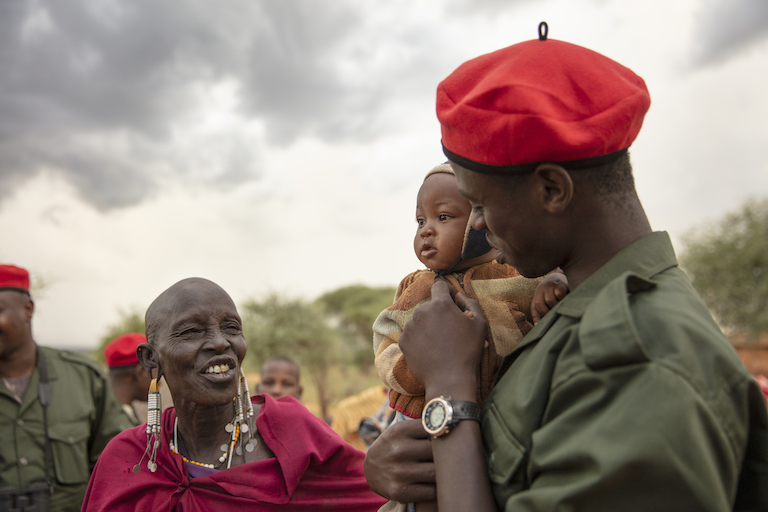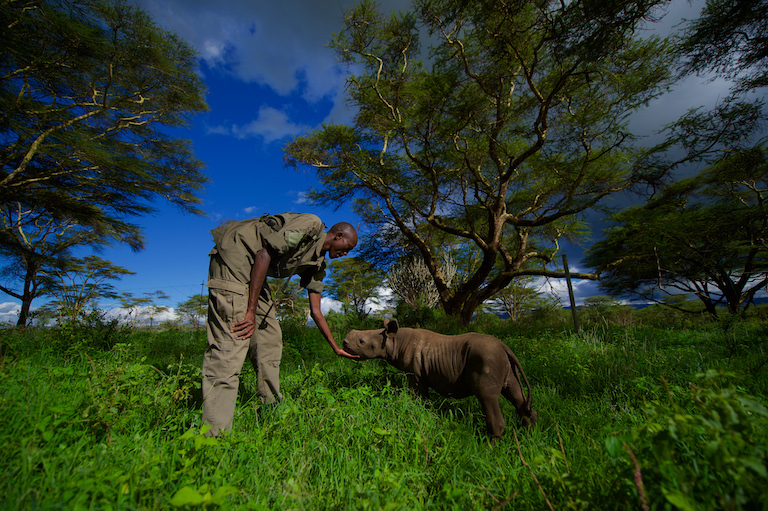- Wildlife ranger groups across Africa are struggling to maintain operations due to the COVID-19 pandemic drying up funding sources, which has resulted in ranger redundancies and salary reductions.
- Tusk, a U.K. nonprofit, is spearheading the Wildlife Ranger Challenge, a race and fundraiser that aims to help keep wildlife rangers employed.
- $2 million has already been distributed as emergency funding to several wildlife ranger groups.
“Sorry, I need to take it,” says Leitah Mkhabela, supervisor for the Black Mamba Anti-Poaching Unit, when her phone buzzes a few minutes into our interview. When she calls back, she says her team needed to update her on a set of poacher’s tracks found in Balule Nature Reserve, a region bordering South Africa’s Kruger National Park, known for its populations of vulnerable African elephants (Loxodonta africana), near threatened white rhinos (Ceratotherium simum) and critically endangered black rhinos (Diceros bicornis).
Like most wildlife ranger groups, Mkhabela and her team at the Black Mambas, a mostly female ranger unit, have been busier than usual during the COVID-19 pandemic. During the country’s lockdown period, most of the rangers were required to stay on duty, working extra hours and unable to see their families. And while poaching incidents haven’t necessarily gone up in their immediate area, they’re anticipating an uptick once the borders open again.

And then, on top of everything else, there are money problems due to the pandemic drying up some funding sources.
“We’ve been struggling with the funding because of this lockdown, and there are so many things … where we need more funding to continue the project, to do everything that we do,” Mkhabela told Mongabay. “It’s been difficult [what] we’ve been experiencing.”
The Black Mambas isn’t the only ranger group facing these kinds of difficulties. Other African rangers groups have had to make staff redundant, or significantly cut ranger salaries, according to Charlie Mayhew, chief executive of Tusk, a U.K. nonprofit that supports African wildlife conservation projects.
“In some cases, we’ve seen salary cuts of between 60 and 80% being taken by these rangers,” Mayhew told Mongabay.

Rangers are often the “breadwinners” of their families, so these cuts would be deeply felt, said Andrew Campbell, chief executive officer of the Game Rangers Association of Africa (GRAA). “They can support up to 20 people on one salary, and the salary isn’t substantial to start with,” he told Mongabay.
To help keep rangers employed, Tusk partnered with several organizations, including GRAA, to establish the Wildlife Ranger Challenge, an initiative that involves a race and an ambitious fundraiser. Ranger teams across Africa will be competing in a half-marathon on Oct. 3 while carrying a typical day’s worth of equipment. One hundred ranger teams from 20 different countries will be participating.
“You only need to look for #ForWildlifeRangers on Instagram … and you’ll get a sense of how these rangers are having a lot of fun, engaging with each other in a very competitive spirit,” Mayhew said.
The public is also encouraged to participate in a virtual run or walk, and to support the cause by making a donation. The Scheinberg Relief Fund, an endowment established by businessman and philanthropist Mark Scheinberg, has offered to donate $5 million in matching donations.

Already, the initiative has raised $2 million to support 9,000 rangers, Mayhew said.
“In many ways, it was really emergency funding,” Mayhew said. “The next phase of funding … again will focus on those most in need, but actually, the feedback we’re getting from all of our partners on the ground is that they [ranger groups] can see the end of this year, in sight. But everybody’s really worried about next year. No one is expecting tourism to suddenly come back in any great way. Some people are saying it could take two, three or four years for tourism levels to go back up to where they were pre-COVID.”
Campbell shares similar concerns, especially since many African wildlife conservation projects rely on tourism revenue.
“There’s no sign of recovery in the near future,” Campbell said. “It’s not like you can just turn the tap back on. A lot of the bookings have just disappeared from the systems, and it’ll take some time to build that momentum back up. Also, will travelers feel comfortable to travel with the sort of health issues at play, and also the logistical issues around things like quarantines?”

Twenty-nine members of the Black Mamba Anti-Poaching Unit will be participating in the half-marathon next week, said Valeria van der Westhuizen, media liaison for Transfrontier Africa, the ranger unit’s parent organization. They will run 21 kilometers (13 miles) while carrying 22-kilogram (48.5-pound) backpacks.
Mkhabela says the challenge is already bringing her team closer together, and that it will show the world what a group of women rangers can achieve.
“The challenge is going to make the world realize that we need to focus on our job,” she said. “We need to help each other to make sure that the next generation has a future, and also to protect our wild animals.”
Banner image caption: Wildlife Ranger Challenge participants, the all-female Akashinga anti-poaching unit train in Zimbabwe’s Phundundu Wildlife Area. Image by Brent Stirton / Getty Images for National Geographic.
Elizabeth Claire Alberts is a staff writer for Mongabay. Follow her on Twitter @ECAlberts.
FEEDBACK: Use this form to send a message to the author of this post. If you want to post a public comment, you can do that at the bottom of the page.
